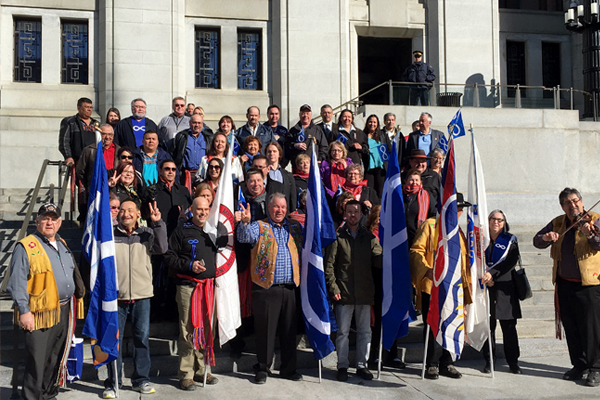The Daniels Case
The Daniels case was heard by the Supreme Court of Canada in October 2015 and was won on April 14, 2016. This landmark case addressed whether the Crown owes the same fiduciary duty to Métis and Non-Status Indians as it does to Treaty Indians.

This landmark case urged Canada to move forward with the Métis community and begin negotiations and implement policies that work for Métis citizens.
MNA Legal Counsel, Jason Madden from Pape Salter Teillet, has provided a full legal summary of the case outcome.
Daniels Decision
Key elements of the Supreme Court of Canada judgement can be found below or you can read the full decision of the Supreme Court of Canada in the Daniels case.
Declaration #1:
A declaration that Métis and Non-Status Indians are within the term “Indians” in Section 91(24) is issued. (para. 58)
- The declaration has practical utility to end the “jurisdictional tug-of-war” (para. 15). The Court acknowledged that the current situation has left Métis and non-status Indian communities in a “jurisdictional wasteland” so an answer to the question is necessary (para. 13). An answer to the question will allow these groups to hold government “accountable for the inadequate status quo” and “guarantee both certainty and accountability” (para. 15)

Harry Daniels
- Section 91(24) is about the federal governments relationship with all of Canada’s Aboriginal peoples—this includes the Métis and Non-Status Indians (para. 49). Section 91(24) and s. 35 should be read together in order to advance reconciliation.
- Constitutional changes, apologies for historic wrongs and appreciation of Aboriginal peoples as partners in Confederation all indicate that reconciliation with all of Canada’s Aboriginal peoples is Parliaments goal (para 37).
- There is no doubt that the Métis are a distinct people (para. 42). No need to delineate between which mixed ancestry communities are Métis and which are non status—they are both “Indians” within s. 91(24) (para. 46) Whether a community is non-status Indian and Métis will be worked out on a case-by-case basis. (para. 47)
- Section 91(24) has a different purpose that s. 35. Section 91(24) is about the federal governments relationship with Canada’s aboriginal peoples. Section 35 deals with the recognition and affirmation or rights and claims. (para. 49).
- The Court goes out of its way to note that Métis and Non-Status Indian inclusion in s. 91(24) does not mean that all provincial legislation with respect to these groups are ultra vires (i.e., outside of the authority of provincial legislatures). This means that the Alberta Métis Settlements legislation is not problematic or inconsistent with Métis inclusion in s. 91(24).
Declaration #2:
The Crown is in a fiduciary relationship with all Aboriginal peoples, including, the Métis and Non-Status Indians.
Declaration #3
There is already a Crown duty to negotiate with Métis and Non-Status Indian communities recognized in law.